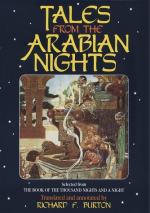[FN#246] The Ashrafi (Port. Xerafim) is a gold coin whose value has greatly varied with its date from four shillings upwards. In The (true) Nights we find (passim) that, according to the minting of the VIth Ommiade, ’Abd al-Malik bin Marwan (A.H. 65-86=A.D. 685-703), the coinage of Baghdad consisted of three metals. “Ita quoque peregrina suis nummis nomina posuit, aureum Dinar denarium, argentem Dirhen (lege dirham), Drachma, aereum fols (fuls), follem appellans. * * * Nam Vera moneta aurea nomine follis lignabatur, ut aereorum sub Aarone Raschido cussorum qui hoc nomen servavit.” (O. G. Tychsen p. 8. Introduct. in Rem numariam Muhammedanorum.) For the dinar, daric or miskal see The Nights, vol i. 32; ix. 294; for the dirham, i. 33, ii. 316, etc.; and for the Fals or Fils=a fish scale, a spangle of metal, vol. i. 321. In the debased currency of the Maroccan Empire the Fals of copper or iron, a substantial coin, is worth 2,160 to the French five-franc piece.
[FN#247] In the Hindi, as in Galland’s version, the horse is naturally enough of Turcoman blood. I cannot but think that in India we have unwisely limited ourselves for cavalry remounts to the Western market that exports chiefly the mongrel “Gulf Arab” and have neglected the far hardier animal, especially the Gutdan blood of the Tartar plains, which supply “excellent horses whose speed and bottom are” say travellers in general, “so justly celebrated throughout Asia.” Our predecessors were too wise to “put all the eggs in one basket.”
[FN#248] An act of worship, see my Pilgrimage in which “Tawaf"=circuiting, is described in detail, ii. 38; iii. 2O1 et seqq. A counterpart of this scene is found in the Histoire du Sultan Aqchid (Ikhshid) who determined to witness his own funeral. Gauttier vol. i. pp. 134-139. Another and similar incident occurs in the “Nineteenth Vezir’s Story” (pp. 213-18 of the History of the Forty Vezirs, before alluded to): here Hasan of Basrah, an ’Alim who died in A.H. 110 (=A.D. 728) saw in vision (the “drivel of dreams?”) folk of all conditions, sages, warriors and moon-faced maids seeking, but in vain, to release the sweet soul of the Prince who had perished.
[FN#249] Here, after Moslem fashion, the mother ranks before the wife: “A man can have many wives but only one mother.” The idea is old amongst Easterns: see Herodotus and his Christian commentators on the history of Intaphernes’ wife (Thalia, cap. cxix). “O King,” said that lady of mind logical, “I may get me another mate if God will and other children an I lose these; but as my father and my mother are no longer alive, I may not by any means have another brother,” etc., etc.
[FN#250] In Galland the Histoire de Ganem, fils d’Abu Aioub, surnomme l’esclave d’Amour, precedes Zayn al-Asnam. In the Arab texts Ghanim bin Ayyub, the Thrall o’ Love, occurs much earlier: see The Nights vol. ii. 45.
It is curious to compare the conclusions of these tales with the formula of the latest specimens, the Contes Arabes Modernes of Spitta-Bey, e.g. “And the twain lived together (p. iii.) and had sons and daughters (p. ii.), cohabiting with perfect harmony (fi al-Kamal pp.42, 79); and at last they died and were buried and so endeth the story” (wa khalas p.161).




